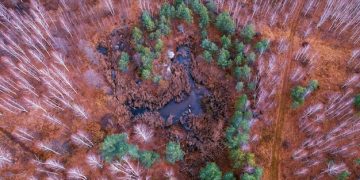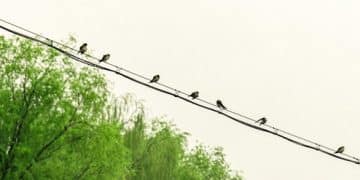The Impact of Light Pollution on Wildlife: Reducing Your Footprint in 2025
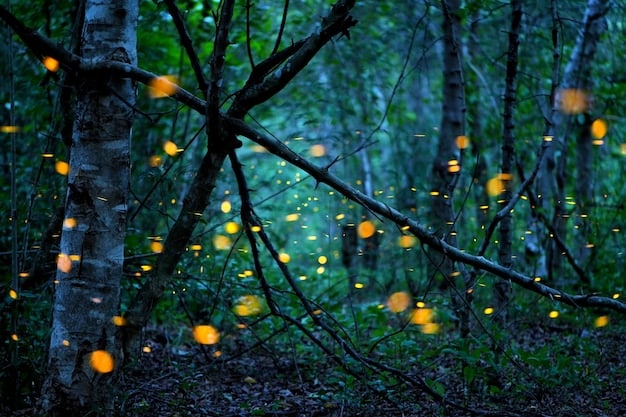
The impact of light pollution on nocturnal wildlife is significant, disrupting natural behaviors and ecosystems; however, simple steps implemented by individuals and communities in 2025 can drastically reduce this footprint, promoting healthier environments for all species.
The pervasive glow of artificial lights dramatically alters the natural world, and understanding the impact of light pollution on nocturnal wildlife: simple steps to reduce your footprint in 2025, is now more crucial than ever.
Understanding Light Pollution and Its Sources
Light pollution extends far beyond simple glare; it encompasses a range of issues stemming from excessive and misdirected artificial light. Understanding the sources of this pollution is the first step toward mitigation.
What Constitutes Light Pollution?
Light pollution refers to any adverse effect of artificial light, including skyglow, light trespass, glare, and clutter. These elements disrupt natural light cycles and negatively affect both humans and wildlife.
Light trespass occurs when unwanted light enters an area, such as a bedroom window, while glare reduces visibility and causes discomfort. Skyglow, the brightening of the night sky, obscures stars and disrupts nocturnal behaviors.
Major Sources of Light Pollution
The primary sources of light pollution include residential, commercial, and industrial lighting, as well as streetlights and advertising. Each source contributes differently to the overall problem.
- Residential Lighting: Outdoor fixtures like porch lights, floodlights, and landscape lighting often lack proper shielding, emitting light upward and outward.
- Commercial and Industrial Lighting: Businesses frequently use bright, unshielded lights for security and advertising, contributing significantly to skyglow.
- Streetlights: Poorly designed streetlights emit light in all directions, rather than focusing it on the road, creating widespread light pollution.
- Advertising: Billboards and illuminated signs are designed to attract attention, but they also add to the overall level of artificial light at night.
By identifying and addressing these major sources, communities can begin to make meaningful reductions in light pollution. Every small step contributes to a more sustainable and balanced environment.
The Dire Consequences for Nocturnal Wildlife
Nocturnal animals have evolved to thrive in the dark, relying on natural light cycles for crucial activities like hunting, mating, and navigation. Light pollution throws these behaviors into disarray, often with fatal consequences.
Disrupted Navigation and Orientation
Many species use the moon and stars to navigate during migration or hunting. Artificial lights confuse these animals, leading them astray and increasing their risk of collision with buildings or vehicles.
Migratory birds, for instance, are particularly vulnerable to disorientation from bright lights, causing them to deviate from their routes and expend vital energy. This can significantly reduce their chances of survival. Similarly, sea turtle hatchlings, which instinctively move toward the brightest horizon, can be drawn inland by artificial lights, where they are at risk of dehydration and predation.
Impact on Hunting and Predation
Light pollution can alter the balance between predators and prey. Some predators use artificial lights to their advantage, increasing their hunting success, while other species become more vulnerable under the unnatural brightness.
For example, some bat species avoid well-lit areas, which limits their ability to forage for insects. This can lead to declines in bat populations and disrupt the natural control of insect populations. Conversely, certain predatory birds may benefit from the increased visibility provided by artificial lights, preying more effectively on nocturnal insects. This imbalance can cascade through the ecosystem, affecting various species.
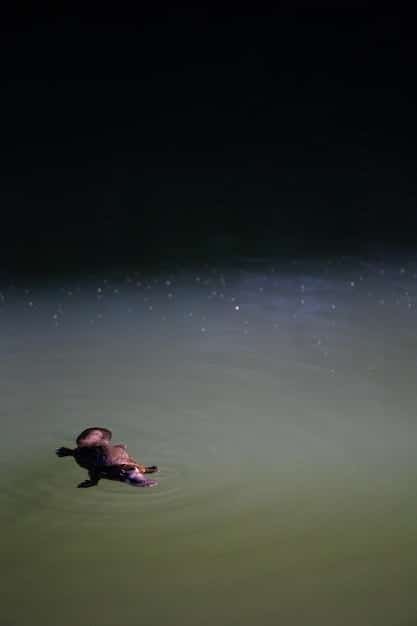
Reproductive Interference
Artificial light can also interfere with the reproductive cycles of nocturnal animals. Many species rely on specific light cues to trigger mating behaviors or synchronize breeding seasons.
For example, amphibians are sensitive to light levels, and exposure to artificial light can disrupt their breeding behavior. This can result in reduced reproductive success and declining populations. Similarly, insects, which often rely on pheromones to attract mates, can find their communication disrupted by artificial light, hindering their ability to reproduce.
The collective impact of these consequences underlines the urgency of addressing light pollution. Protecting nocturnal wildlife requires a concerted effort to reduce artificial light at night and restore natural darkness.
Simple Steps to Reduce Your Light Footprint in 2025
Reducing your light footprint involves making conscious choices about the type and amount of outdoor lighting you use. By adopting simple strategies, you can significantly minimize your impact on nocturnal wildlife.
Switch to Shielded Lighting
Shielded lights direct light downward, preventing it from escaping upward and outward. This not only reduces light pollution but also improves visibility by focusing light where it’s needed.
Full cutoff fixtures are the most effective type of shielded lighting, ensuring that no light is emitted above the horizontal plane. These fixtures can be easily installed in place of existing unshielded lights. Furthermore, switching to shielded lighting can also save energy by directing light more efficiently, reducing the need for overly bright bulbs.
Use Lower Intensity Bulbs
Bright lights are not always necessary for safety and security. Using lower intensity bulbs can reduce light pollution without compromising visibility. Consider using bulbs with a lower lumen output.
LEDs are an excellent option for outdoor lighting because they are energy-efficient and available in a range of intensities. It’s also important to choose bulbs with a warm color temperature (around 2700K), as these emit less blue light, which is particularly harmful to wildlife. Experimenting with different bulb intensities can help you find the right balance between brightness and environmental impact.
Employ Timers and Motion Sensors
Timers and motion sensors can help reduce unnecessary lighting by only activating lights when they are needed. This minimizes light pollution and conserves energy.
Timers can be programmed to turn lights off at specific times, while motion sensors activate lights only when movement is detected. These technologies are particularly useful for security lighting, ensuring that lights are not left on all night. Implementing timers and motion sensors is a simple and cost-effective way to reduce your light footprint.
Advocate for Dark Sky Initiatives
Support local initiatives aimed at reducing light pollution in your community. This can include advocating for better street lighting policies, promoting awareness, and participating in dark sky events.
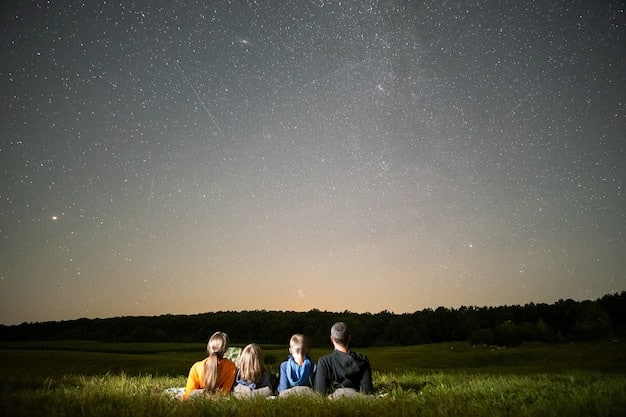
Dark sky initiatives often involve partnerships between local governments, community organizations, and businesses. These initiatives can lead to the implementation of lighting standards that protect nocturnal wildlife and preserve the night sky. By getting involved, you can help create a more sustainable and wildlife-friendly community.
Community-Wide Efforts for Darker Nights
While individual actions are important, community-wide efforts are essential for achieving significant reductions in light pollution. Collective action magnifies the impact and fosters a more sustainable environment.
Implementing Lighting Ordinances
Local governments can adopt lighting ordinances that regulate the type and amount of outdoor lighting allowed in the community. These ordinances can require the use of shielded fixtures, limit the intensity of lights, and establish curfews for non-essential lighting.
Effective lighting ordinances are based on scientific evidence and tailored to the specific needs of the community. They often include provisions for enforcement and incentives for compliance. By implementing comprehensive lighting ordinances, communities can create darker and healthier environments for both wildlife and residents.
Promoting Public Awareness
Raising public awareness about the impacts of light pollution is crucial for gaining support for mitigation efforts. Educational campaigns can inform residents about the benefits of reducing light pollution and provide practical tips for taking action.
Public awareness campaigns can utilize various media, including social media, local newspapers, and community events. These campaigns can highlight the effects of light pollution on wildlife, human health, and energy consumption. By increasing public awareness, communities can mobilize residents to support and participate in light pollution reduction efforts.
Collaborating with Businesses
Businesses can play a significant role in reducing light pollution by adopting responsible lighting practices. This includes using shielded fixtures, reducing light intensity, and turning off non-essential lights when the business is closed.
Local governments and community organizations can collaborate with businesses to provide guidance and incentives for implementing these practices. This can include offering rebates for the installation of energy-efficient lighting and recognizing businesses that demonstrate a commitment to reducing light pollution. By working together, communities and businesses can create brighter futures with minimal light impact.
Through these community-wide efforts, societies can dramatically decrease the impact of light pollution on nocturnal wildlife, fostering sustainable environments and protecting the wonders of the night sky.
Technological Innovations in Light Pollution Reduction
Advancements in technology are providing new tools and strategies for mitigating light pollution. These innovations offer promising solutions for reducing artificial light at night and protecting nocturnal wildlife.
Smart Lighting Systems
Smart lighting systems use sensors and controls to adjust lighting levels based on real-time conditions. These systems can dim lights when they are not needed and adjust the color temperature to minimize the impact on wildlife.
Smart lighting systems can be programmed to respond to changes in ambient light levels, traffic patterns, and weather conditions. They can also be integrated with other smart city technologies, such as energy management systems, to optimize energy consumption. By using smart lighting systems, communities can reduce light pollution while also improving safety and efficiency.
Adaptive Street Lighting
Adaptive street lighting adjusts the brightness of streetlights based on the presence of vehicles or pedestrians. This reduces energy consumption and minimizes light pollution during periods of low activity.
Adaptive street lighting systems use sensors to detect movement and adjust the light level accordingly. They can also be programmed to gradually dim lights over time, reducing light pollution throughout the night. These systems are particularly well-suited for residential areas and rural roads, where traffic levels vary significantly.
Development of Wildlife-Friendly Lighting
Researchers are developing new types of lighting that are specifically designed to minimize the impact on wildlife. This includes lights with a narrow spectrum of wavelengths and lights that emit no ultraviolet or blue light, which are particularly disruptive to nocturnal animals.
Wildlife-friendly lighting is based on a growing understanding of how different species respond to artificial light. These lights are designed to be less attractive to insects, which reduces their impact on insectivorous animals. They also minimize the disruption of natural light cycles, allowing nocturnal animals to maintain their natural behaviors. Investing in wildlife-friendly lighting is a proactive step towards protecting biodiversity.
By embracing these technological innovations, communities can make significant strides in reducing light pollution and creating healthier environments for nocturnal wildlife.
The Long-Term Benefits of Reducing Light Pollution
Reducing light pollution yields numerous long-term benefits, extending beyond the immediate protection of nocturnal wildlife. These benefits encompass human health, energy conservation, and the preservation of cultural heritage.
Improved Human Health
Exposure to artificial light at night has been linked to a variety of health problems, including sleep disorders, increased risk of cancer, and metabolic dysfunction. Reducing light pollution can improve sleep quality and promote overall well-being.
Studies have shown that exposure to blue light, in particular, can suppress the production of melatonin, a hormone that regulates sleep. By reducing light pollution, individuals can restore their natural sleep cycles and reduce their risk of related health problems. Creating darker nights is an investment in public health.
Energy Conservation
Reducing light pollution can lead to significant energy savings. By using less light, employing more efficiency fixtures, and turning off lights when they are not needed, communities can reduce their energy consumption and lower their carbon footprint.
Energy savings from light pollution reduction can translate into lower utility bills for residents and businesses. It can also reduce the demand for fossil fuels and contribute to a more sustainable energy future. Embracing responsible lighting practices is a win-win for the environment and the economy.
Preservation of Cultural Heritage
The night sky is a valuable cultural resource that has inspired artists, poets, and scientists for centuries. Light pollution obscures the stars and diminishes our connection to the cosmos. By reducing light pollution, we can preserve the beauty of the night sky for future generations.
Dark sky parks and reserves are becoming increasingly popular destinations for tourists seeking to experience the wonders of the night sky. These areas provide opportunities for stargazing, astronomy education, and cultural appreciation. Protecting the night sky is a way to celebrate our shared human heritage.
In conclusion, the long-term benefits of reducing light pollution are far-reaching and multifaceted. By taking action to create darker nights, we can improve human health, conserve energy, and preserve our cultural heritage.
| Key Point | Brief Description |
|---|---|
| 💡 Shielded Lighting | Directs light downwards, reducing skyglow and improving visibility. |
| 🦉 Wildlife Impact | Disrupts navigation, hunting, and reproduction of nocturnal animals. |
| 🌃 Dark Sky Initiatives | Community efforts to reduce light pollution through ordinances and awareness. |
| ✨ Smart Lighting | Adjusts lighting levels based on real-time conditions, conserving energy. |
FAQ
Light pollution is the excessive or misdirected artificial light that disrupts natural patterns, affecting humans, wildlife, and the night sky. It includes skyglow, glare, and light trespass.
It disrupts navigation by confusing animals reliant on natural light, interferes with hunting and predator-prey balance, and affects reproductive cycles, often leading to population declines.
Shielded lights direct light downward, preventing it from escaping upward. This minimizes light pollution, saves energy, and improves visibility by focusing light where it’s actually needed.
Communities can implement lighting regulations, promote public awareness, and collaborate with businesses to adopt responsible lighting practices. These collective efforts lead to more significant reductions.
Technology offers smart lighting systems that adapt to real- time conditions. Adaptive street lighting dims based on traffic, and wildlife-friendly lights minimize disruption by omitting disruptive wavelengths.
Conclusion
As we move further into 2025, tackling light pollution becomes increasingly vital for preserving our planet’s biodiversity and ensuring a sustainable future. By embracing simple steps, advocating for community-wide initiatives, and leveraging technological advancements, we can significantly reduce our light footprint and protect nocturnal wildlife for generations to come.


